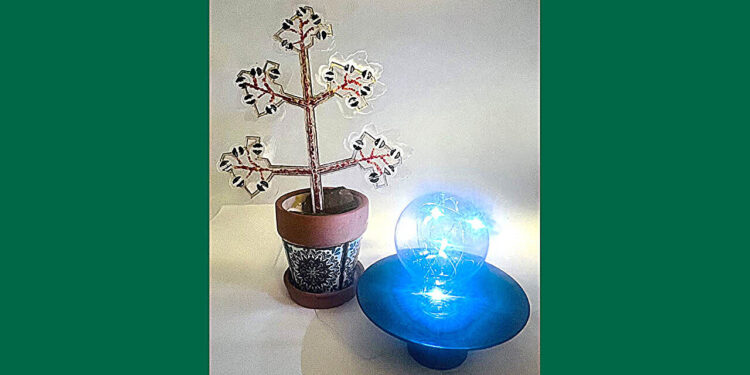Professor Seokheun “Sean” Choi of Binghamton University and doctoral student Maryam Rezaie have developed artificial plants that can feed on carbon dioxide, release oxygen and even produce electricity. Credit: Binghamton University
On average, Americans spend about 90% of their time indoors, and the air we breathe at work, school, or home affects our overall health and well-being.
However, most air purification systems are expensive, bulky, and require frequent cleaning or filter replacement to operate at optimal levels.
Seokheun “Sean” Choi, a Binghamton University professor and Ph.D. Maryam Rezaie, a student, is redirecting her research on biobatteries powered by bacteria, ingestible or not, towards a new idea of artificial plants capable of feeding on carbon dioxide, releasing oxygen and even generating a little energy. energy.
They present their results in an article recently published in the journal Advanced sustainable systems.
“Especially after going through COVID-19, we know the importance of indoor air quality,” said Choi, a faculty member in the department of electrical and computer engineering in the Thomas J. Watson College of Engineering and Applied Science.
“Many sources can generate very toxic materials, such as building materials and carpets. We exhale and inhale, which increases carbon dioxide levels. There are also risks from cooking and seepage from the outside.”
Using five biological solar cells and their photosynthetic bacteria, Choi and Rezaie created an artificial leaf “for fun,” then realized the concept had broader implications. They built the first five-leaf plant, then tested its carbon dioxide capture rates and oxygen generation capacity.
Although power generation of around 140 microwatts is a side benefit, Choi hopes to improve the technology to achieve a minimum power output of more than 1 milliwatt. He also wants to integrate an energy storage system, such as lithium-ion batteries or supercapacitors.
“I want to be able to use that electricity to charge a cell phone or for other practical uses,” he said.
Other improvements could include using multiple species of bacteria to ensure long-term viability and developing ways to minimize maintenance, such as water and nutrient delivery systems.
“With a few adjustments, these artificial plants could become a part of every home,” Choi said. “The benefits of this idea are easy to see.”
More information:
Maryam Rezaie et al, Cyanobacterial artificial plants for enhanced indoor carbon capture and utilization, Advanced sustainable systems (2024). DOI: 10.1002/adsu.202400401
Provided by Binghamton University
Quote: Researchers create artificial plants that purify indoor air and generate electricity (October 4, 2024) retrieved October 4, 2024 from
This document is subject to copyright. Except for fair use for private study or research purposes, no part may be reproduced without written permission. The content is provided for informational purposes only.



